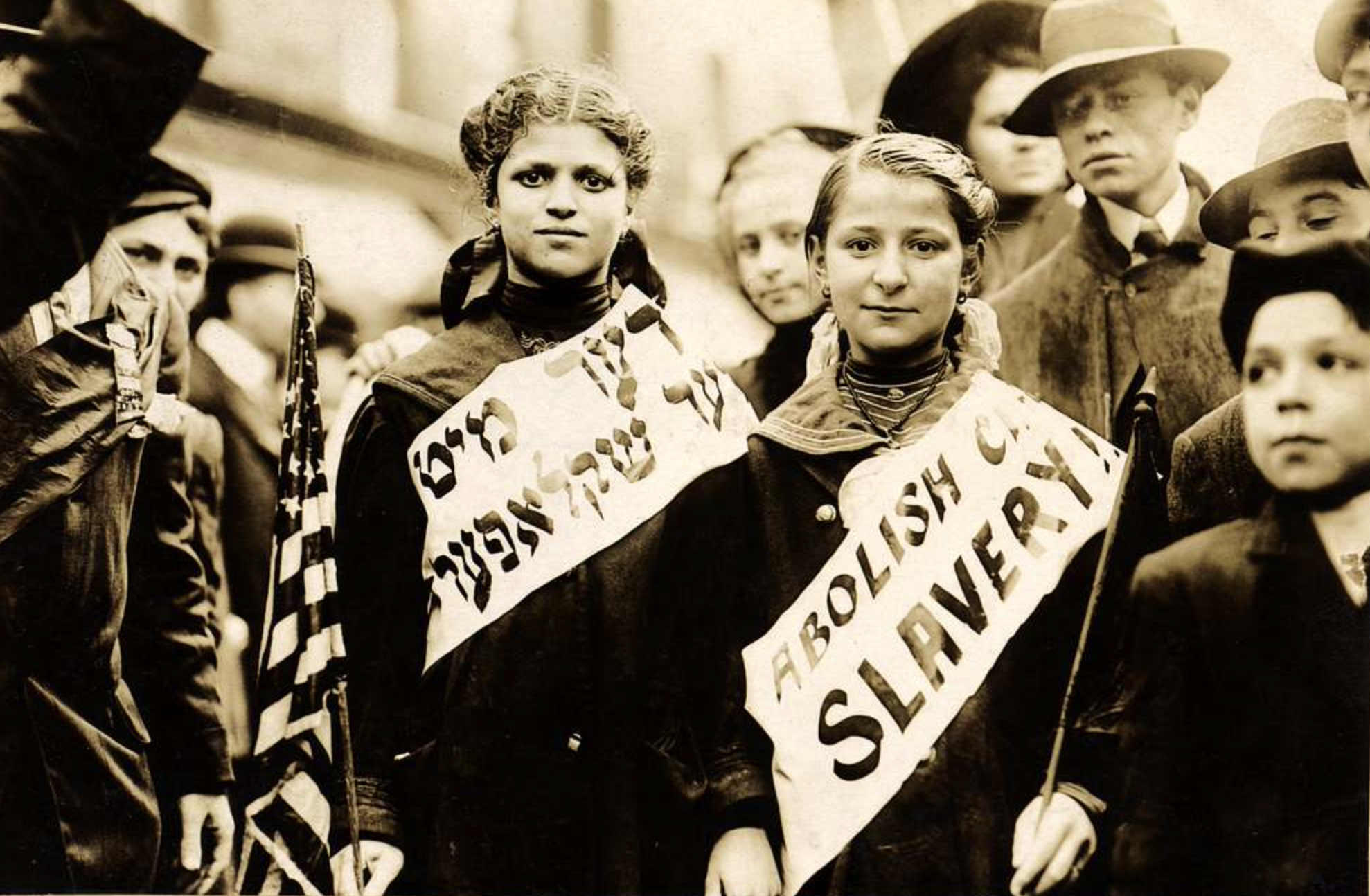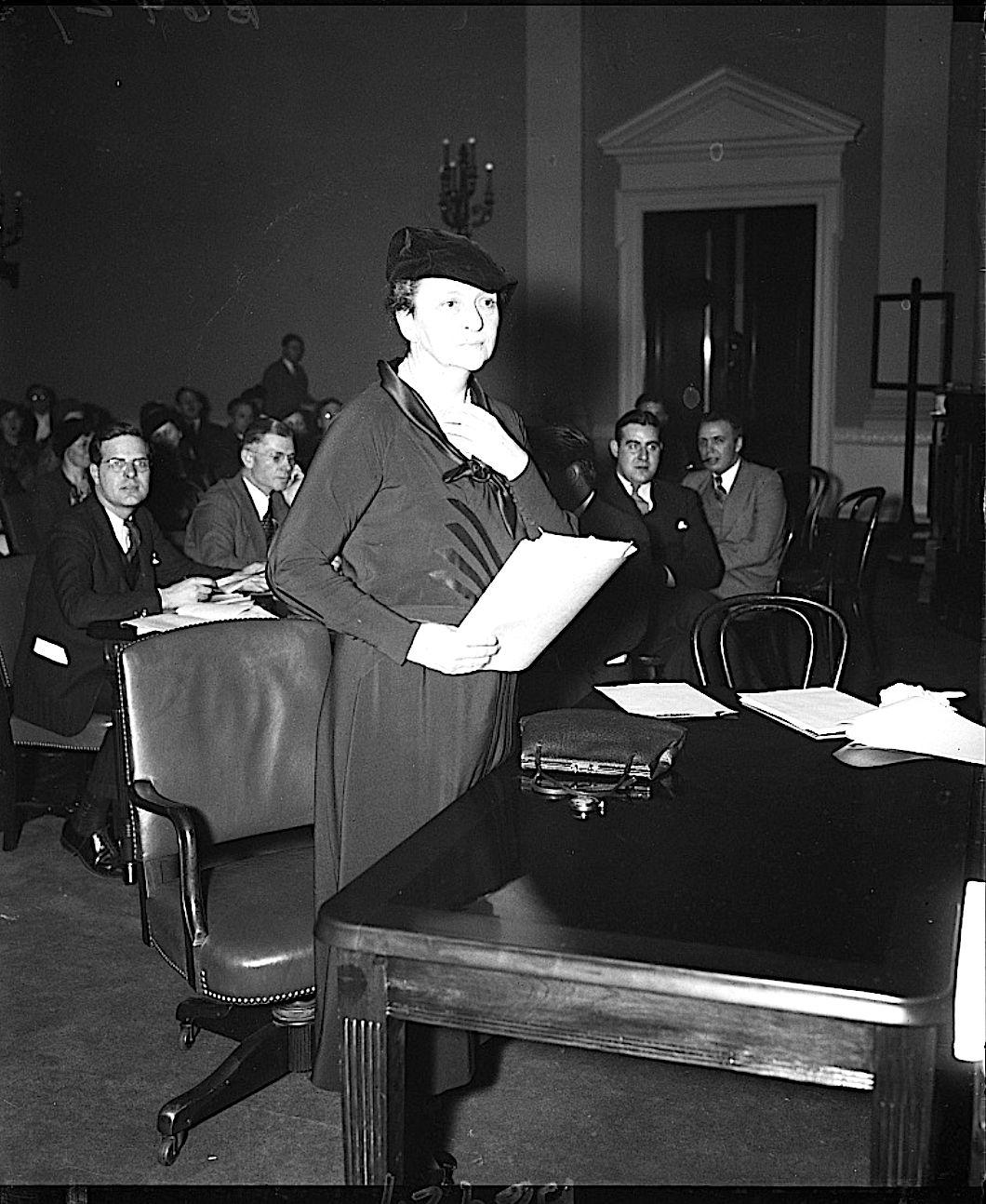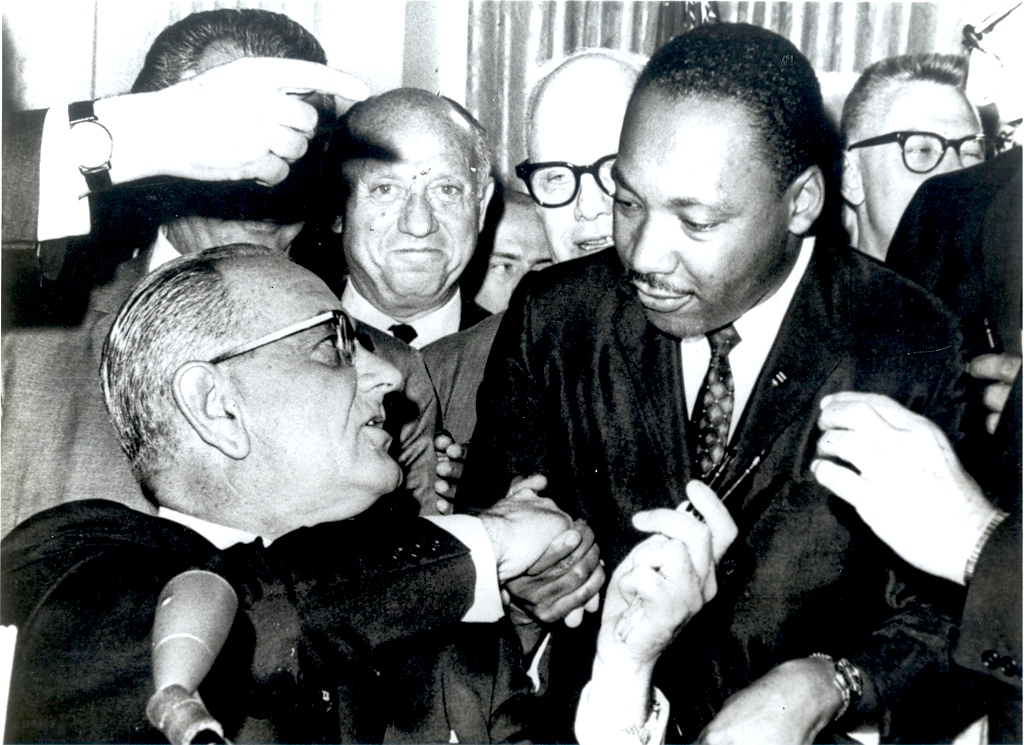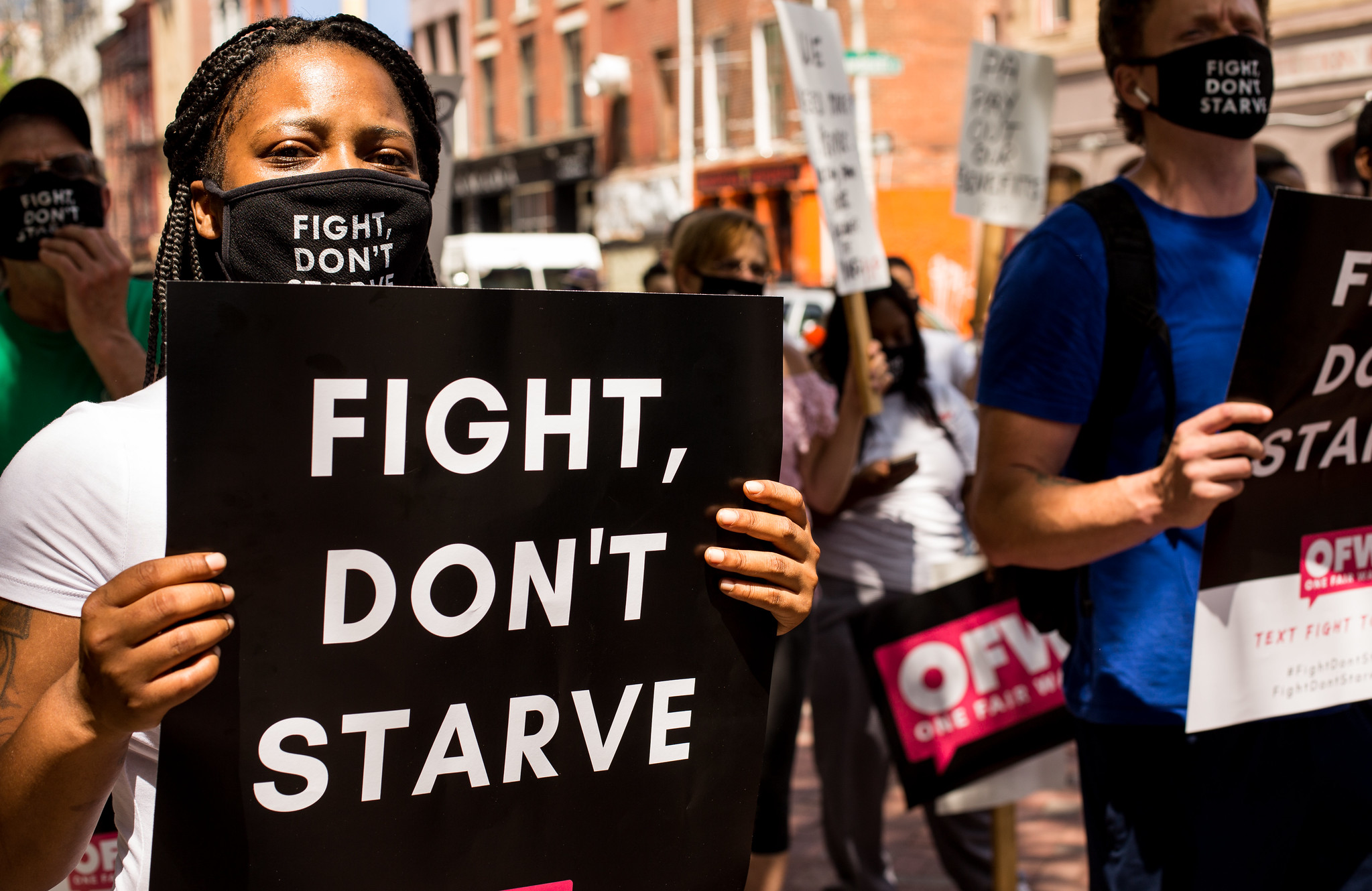Without any mechanisms to adjust for rising prices, the real value of the federal minimum wage hit a 66-year low in 2023, say the authors. It’s now worth 42 percent less than its highest point in 1968.

Two girls wearing banners with slogan “Abolish Child Slavery!!” in English and Yiddish,, one carrying American flag; probably taken during May 1, 1909, labor parade in New York City. (Library of Congress)
By Jasmine Payne-Patterson and Adewale A. Maye
EPI Blog

 The minimum wage is a New Deal era policy established initially through the Fair Labor Standards Act, or FLSA, of 1938.
The minimum wage is a New Deal era policy established initially through the Fair Labor Standards Act, or FLSA, of 1938.
The original bill set a wage floor, instituted a 44-hour work week, and protected children from prematurely entering the workforce. Since its inception, the FLSA has been amended multiple times, with added exemptions and expansions specifying which groups of workers are covered under different aspects of the law.
The latest proposed changes in Congress — the Raise the Wage Act of 2023 — would increase the federal minimum wage to $17 per hour. In light of this new legislation, we take a look back at the 85-year history of the minimum wage, how it differs in states and localities, and how minimum wage laws continue to have implications for racial, gender, and economic justice today.
History

President Roosevelt delivering Fireside Chat No. 6, Sept. 30, 1934. (FDR Presidential Library & Museum, Flickr, CC BY 2.0)
The concept behind the FLSA began in the 1930s as a response to the Great Depression, a time when about 25 percent of workers were unemployed, people lost their life savings due to bank failures and many struggled to secure housing and food.
In 1933, President Franklin Delano Roosevelt responded with the National Industrial Recovery Act (NIRA) and establishing the National Recovery Administration (NRA). Through these policies, the Roosevelt administration sought to revive the economy and help the nation recover by instituting industrywide “fair competition” codes intended to set wages and prices, create jobs and permit collective bargaining.
From the NRA, over 2 million businesses sought to earn pro-worker “Blue Eagle” branding by signing agreements for policies such as a weekly $12–$15 minimum wage, a commitment not to hire workers younger than 16 years old, and a work week no longer than 40 hours.

Female film industry workers carrying a large U.S. flag as part of a National Recovery Administration parade in New York City, 1933. (World-Telegraph staff photograph, Library of Congress)
However, the Supreme Court invalidated the NIRA by ruling that the executive branch did not have the power to institute the codes. The court’s opposition warranted another vehicle for worker protections; therefore, the Roosevelt administration sought to craft legislation that would protect workers, garner enough support to pass Congress and explicitly align with the Constitution to avoid legal challenges.
Efforts to pass this legislation increased as public outcry over the Supreme Court decision grew.
When Roosevelt was campaigning for reelection in Massachusetts, a young girl working at a factory attempted to hand him a note, but a policeman blocked her. Roosevelt instructed his aid to get the note which pleaded for help stating, “We have been working in a sewing factory… and up to a few months ago we were getting our minimum pay of $11 a week… Today the 200 of us girls have been cut down to $4 and $5 and $6 a week.” Responding to the girl’s plea, Roosevelt was resolute to create a minimum wage law.
The process for the final bill was extensive — beginning with Roosevelt’s efforts to secure workers’ rights advocate Frances Perkins as secretary of labor, who shared his goals for labor standards.
Perkins became the first woman to hold a cabinet position and proposed a law to establish a minimum wage, set a cap on hours worked per week and set restrictions on child labor.
One of the bills became the FLSA and after three sessions of Congress, the legislation finally passed. Roosevelt signed the FLSA into law on June 25, 1938, and it became effective on Oct. 24, 1938.
Supporters & Opponents

U.S. Labor Secretary Perkins addressing a House committee in January 1935. (Harris & Ewing, photographer, Library of Congress)
Supporters of the bill emphasized the necessity to create better conditions for the one-third of Americans who were financially struggling, noting the law would improve labor standards for the labor force.
Proponents said the bill would end “unnecessarily long hours which wear out part of the working population while they keep the rest from having work to do.” They noted that a minimum wage would support the entire wage infrastructure by creating a floor that workers could leverage to achieve higher wages through collective bargaining.
Some labor organizers of the time worried that employers would not pay above the minimum wage set by the law, so they advocated for the bill to only cover low-paid workers who were not part of unions. Consequently, the initial bill excluded work protected by collective bargaining.
By the 1950s, unions began to support and advocate for expanding the minimum wage to also cover union workers.
Opponents of the bill insisted that higher wages would cause labor cuts, but the administration fought back harder.
In a fireside chat discussing the bill, Roosevelt said, “Do not let any calamity-howling executive with an income of $1,000 a day… tell you… that a wage of $11 a week is going to have a disastrous effect on all American industry.”
Incorrect statements from businesses opposing the minimum wage continue to the present day with assertions that minimum wage increases would cause businesses to close or reduce jobs. Studiesdemonstrate how these predictions did not come true.
How the Minimum Wage Has Changed

U.S. President Lyndon Johnson shakes hands with the Reverend Martin Luther King, Jr., after handing him one of the pens used in signing the Civil Rights Act of July 2, 1964, at the White House. (U.S. Embassy New Delhi, Flickr, CC BY-ND 2.0, Library of Congress, Prints & Photographs Division)
The Fair Labor Standards Act has been amended several times since the original 1938 bill. The most recent change became effective July 24, 2009, increasing the federal minimum wage to $7.25. Despite numerous efforts, there have been no federal minimum wage increases since then.
Table 1 highlights federal minimum wage increases over time in nominal dollars compared with what that wage would be in inflation-adjusted 2023 dollars. Congress raised the minimum wage fairly consistently for decades, but that began to change in the 1980s, with increases becoming fewer and farther between.

Without any mechanisms in place to automatically adjust it for rising prices, the real value of the federal minimum wage has gradually declined, reaching a 66-year low in 2023, where it is now worth 42 percent less than its highest point in 1968. Moreover, the federal minimum wage is worth 30% less today than when it was last raised 14 years ago. This significant loss in purchasing power means that the federal minimum wage today is nowhere close to a living wage.
Exemptions
The FLSA provided several exemptions for specific categories of workers, including executives, administrators, professionals, and certain outside sales employees. However, another major group of workers exempted under the FLSA was agricultural, domestic and other service-sector employees.
The implications of these exemptions were significant for workers earning low wages, particularly those in marginalized communities. Excluded workers were left vulnerable to exploitation and unable to access basic labor rights under the law, such as a fair minimum wage and overtime pay.
The exemptions deepened economic disparities and perpetuated a two-tiered system where some workers were entitled to protections and benefits, while others were left unprotected, exacerbating a cycle of poverty and wage inequality.
It was not until later amendments to the FLSA and the Civil Rights Act of 1964 that many of these exclusions were addressed. However, many of these workers — including in the agricultural sector — continue to face exploitative working conditions, long hours and meager pay.

Harvesting strawberries in Salinas, California, 2009. (Holgerhubbs, Wikimedia Commons, CC BY 3.0
Racial Impact
When the FLSA was first introduced, many of the industries that were exempted from a minimum wage were also industries that Black workers were heavily represented in. Some have argued that Roosevelt had excluded industries that were predominately held by Black workers to gain favor from Southern lawmakers. These exemptions kept Black workers vulnerable to wage theft, excessively long hours without overtime and an overall lack of workplace protections.
As amendments were made to the FLSA over the subsequent decades, more of the labor force was covered. The 1966 amendments expanded coverage and introduced a $1 wage floor to several new sectors, including agriculture, schools, nursing homes and restaurants — sectors where Black workers were disproportionately employed. As a result, the expansion of the minimum wage had an especially positive impact on Black workers, nearly double that of white workers.
However, the 1966 amendments also allowed employers to credit a portion of employees tips toward workers’ minimum wages, permitting employers to reduce wage obligations to tipped staff. That means that tipped workers, predominately working in restaurants and other service sectors, saw both an expansion of coverage and a reduction of payfrom employers simultaneously. Sadly, many of these workers were also women and workers of color.
Without eliminating the lower subminimum wage for tipped workers, workers of color will struggle to sustain economic security.
Additionally, the failure to adjust the minimum wage adequately to keep pace with inflation and economic growth has undermined its effectiveness in addressing racial income inequality.
Today, Black workers are paid 10 percent to 15 percent less than white workers with the same characteristics. Similarly, maintaining a lower minimum wage for tipped workers continues to preserve racial inequities. Without eliminating the lower subminimum wage for tipped workers, workers of color will struggle to sustain economic security.
State Minimum Wage Levels

Demonstration in Philadelphia on March 16, 2020, for the launch of the One Fair Wage Emergency Fund to help tipped service workers who had disproportionately lost thost their jobs during the pandemic and were underpaid and overworked to begin with. (Joe Piette, Flickr, CC BY-NC-SA 2.0)
States have the authority to set minimum wages higher than the federal minimum wage to account for higher regional wage levels or costs of living. This has led to significant variation in minimum wages across the country, as shown in EPI’s interactive minimum wage tracker.
Thirty states and Washington, D.C., currently set their minimum wages higher than the federal level. And this year alone, 27 states and 42 cities and counties will increase their minimum wages. Across the nation, 19 states and D.C. have minimum wages that increase with inflation, meaning that their minimums will likely increase each year. This year’s increases ranged from $0.23 to $1.50 an hour.
Meanwhile, 20 other states set their minimums at or below the federal level. Employers in states with lower minimums than the federal level can only pay their workers less if they are not covered by the FLSA.
To be subject to the FLSA, companies must gross at least $500,000 in annual sales and engage in interstate commerce. Of these 20 states, seven states have either no minimum-wage law or a minimum wage below the federal minimum wage.
Six of these states are in the South — Alabama, Georgia, Louisiana, Mississippi, South Carolina and Tennessee. Accounting for only 12 percent of U.S. states, these six Southern states represent 23 percent of the Black workforce.
Legislation for $17 Minimum Wage
The most recent proposal to increase the federal minimum wage is the Raise the Wage Act of 2023, which would gradually raise the federal minimum wage to $17 an hour by 2028.
Additionally, the bill seeks to progressively raise and eventually eliminate subminimum wages for tipped workers, workers with disabilities and youth workers, thereby ensuring that all employees covered by the Fair Labor Standards Act receive equal wages.
EPI’s analysis of the Raise the Wage Act of 2023 estimates over 27.8 million workers would benefit, with the average affected worker who works year-round receiving an extra $3,100 per year.
Raising the minimum wage is vital to safeguard workers who have historically been marginalized and left behind. For Black workers specifically, a higher minimum wage would be a critical step in raising living standards and promoting economic justice.
For generations, Black workers have been disproportionately represented in low-wage jobs, making them particularly vulnerable to economic hardships. A higher federal minimum wage would provide much-needed relief to many Black workers, with nearly 30 percent of Black workers benefiting if the federal minimum wage is raised to $17 by 2028. In short, the Raise the Wage Act of 2023 would provide a long overdue boost in wages and administer a stronger, more equitable wage floor for states to follow.
Jasmine Payne-Patterson joined the Economic Policy Institute in 2023 as a senior state policy coordinator for the Economic Analysis and Research Network (EARN).
Adewale A. Maye is a policy and research analyst with the Economic Policy Institute’s Program on Race, Ethnicity, and the Economy.
This article is from EPI Blog.
The views expressed are solely those of the author and may or may not reflect those of Consortium News.
Donate to CN’s
Fall Fund Drive



The ‘minimum wage’ is the real measure of just how exactly illegal ‘slavery’ is in the land.
Slavery is a minimum wage of $0.
Obama/Biden are now heading for 12 years without raising the minimum wage.
Which means that in ‘inflation adjusted’ terms, Obama and Biden have been pushing the nation closer and closer to slavery as the ‘real’ value of the minimum wage decreases. Biden increased this effect with his $Trillion bailouts, very little of which went to minimum wage workers, but which accelerated inflation thus driving the ‘real’ minimum wage lower and lower as he handed out money to the rich folk.
Maybe the current government should read up on the French Revolution— you know the one with all the guillotines. One item I read re: this was that the French people were told that no bread was coming into the city—I suppose that doesn’t sound like enough to start a revolution—-but when people are starving, it’ s impossible to say what the result will be.
We already see roving gangs rushing stores and stealing items in mass and quite often getting away with it. AND it does appear that some corporations have decided that those .working from home, must immediately come back to the physical office asap. OR—they could lose their jobs “Lions, Tigers and Bears—-Oh My.”
Remember Greedy Corporations” Hell hath no fury like a population scorned. : (
….”
For some reason the graph stops at 2009. The full graph is here:
hxxps://economic.github.io/real_minimum_wage/#after-the-longest-period-in-history-without-an-increase-the-federal-minimum-wage-today-is-worth-29-less-than-13-years-agoand-42-less-than-in-1968
The same false argument that a higher minimum wage will reduce the number of jobs is made by “all the usual suspects” in other countries (for example Germany), too.
“Through these policies, the Roosevelt administration sought to revive the economy and help the nation recover by instituting industrywide “fair competition” codes intended to set wages and prices, create jobs and permit collective bargaining.”
No, Roosevelt enacted the NRA to save capitalism. He knew that revolution was going to happen if he didn’t. We should have had a socialist revolution in this country back then. It’s a shame we didn’t.
I agree Carolyn. A missed opportunity that has cost us and the planet dearly.